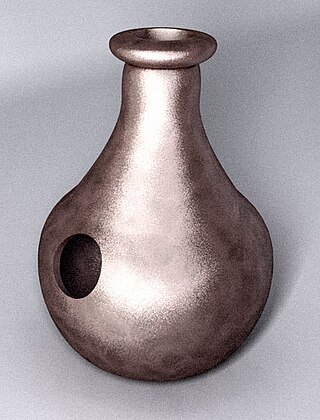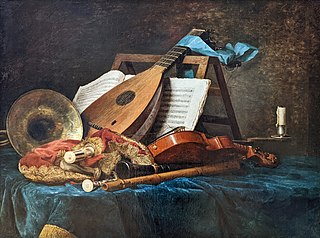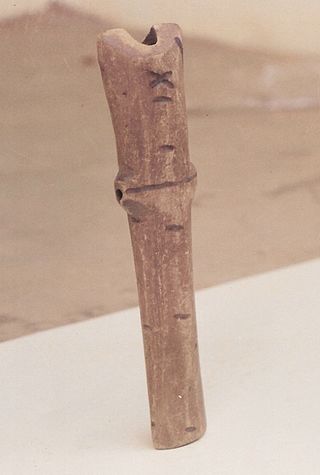Related Research Articles

A drum kit is a collection of drums, cymbals, and sometimes other auxiliary percussion instruments set up to be played by one person. The drummer typically holds a pair of matching drumsticks, and uses their feet to operate hi-hat and bass drum pedals.

The flute is a member of a family of musical instruments in the woodwind group. Like all woodwinds, flutes are aerophones, producing sound with a vibrating column of air. Unlike woodwind instruments with reeds, a flute produces sound when the player's air flows across an opening. In the Hornbostel–Sachs classification system, flutes are edge-blown aerophones. A musician who plays the flute is called a flautist or flutist.

A drum machine is an electronic musical instrument that creates percussion sounds, drum beats, and patterns. Drum machines may imitate drum kits or other percussion instruments, or produce unique sounds, such as synthesized electronic tones. A drum machine often has pre-programmed beats and patterns for popular genres and styles, such as pop music, rock music, and dance music. Most modern drum machines made in the 2010s and 2020s also allow users to program their own rhythms and beats. Drum machines may create sounds using analog synthesis or play prerecorded samples.

Odinani or Odinala, is the traditional cultural belief and practice of the Igbo people of south east Nigeria. These terms, as used here in the Igbo language, are synonymous with the traditional Igbo "religious system" which was not considered separate from the social norms of ancient or traditional Igbo societies. Theocratic in nature, spirituality played a huge role in their everyday lives. Although it has largely been supplanted by Christianity, the indigenous belief system remains in strong effect among the rural and village populations of the Igbo, where it has at times influenced the colonial religions. Odinani is a pantheistic and polytheistic faith, having a strong central deity at its head. All things spring from this deity. Although a pantheon of other gods and spirits, these being Ala, Amadiọha, Anyanwụ, Ekwensu, Ikenga, exists in the belief system, as it does in many other Traditional African religions, the lesser deities prevalent in Odinani serve as helpers or elements of Chukwu, the central deity.

The music of Nigeria includes many kinds of folk and popular music. Little of the country's music history prior to European contact has been preserved, although bronze carvings dating back to the 16th and 17th centuries have been found depicting musicians and their instruments. The country's most internationally renowned genres are Indigenous, Apala, Aurrebbe music, Rara music, Were music, Ogene, Fuji, Jùjú, Afrobeat, Afrobeats, Igbo highlife, Afro-juju, Waka, Igbo rap, Gospel, and Yo-pop. Styles of folk music are related to the over 250 ethnic groups in the country, each with their own techniques, instruments, and songs. The largest ethnic groups are the Igbo, Hausa and Yoruba. Traditional music from Nigeria and throughout Africa is often functional; in other words, it is performed to mark a ritual such as the wedding or funeral and not to achieve artistic goals. Although some Nigerians, especially children and the elderly, play instruments for their own amusement, solo performance is otherwise rare. Music is closely linked to agriculture, and there are restrictions on, for example, which instruments can be played during different parts of the planting season.

The banjo ukulele, also known as the banjolele or banjo uke, is a four-stringed musical instrument with a small banjo-type body and a fretted ukulele neck. The earliest known banjoleles were built by John A. Bolander and by Alvin D. Keech, both in 1917.

The angklung is a musical instrument from the Sundanese people in Indonesia made of a varying number of bamboo tubes attached to a bamboo frame. The tubes are carved to have a resonant pitch when struck and are tuned to octaves, similar to Western handbells. The base of the frame is held in one hand, while the other hand shakes the instrument, causing a repeating note to sound. Each performer in an angklung ensemble is typically responsible for just one pitch, sounding their individual angklung at the appropriate times to produce complete melodies.

The term Chinese orchestra is most commonly used to refer to the modern Chinese orchestra that is found in China and various overseas Chinese communities. This modern Chinese orchestra first developed out of Jiangnan sizhu ensemble in the 1920s into a form that is based on the structure and principles of a Western symphony orchestra but using Chinese instruments. The orchestra is divided into four sections – wind, plucked strings, bowed strings, and percussion, and usually performs modernized traditional music called guoyue. The orchestra may be referred to as Minzu Yuetuan or Minyuetuan in mainland China, Chung Ngok Tuen in Hong Kong, Huayuetuan in Southeast Asia, or Guoyuetuan in Taiwan, all meaning Chinese orchestra.

A slit drum or slit gong is a hollow percussion instrument. In spite of its often being called a drum, it is not a true drum but an idiophone, usually carved or constructed from bamboo or wood, in the form of a mostly closed hollow chamber with one or more slits in it. It is played by striking near the edge of the slit. In some designs, the slit is a single straight line; in others, the slit is used to create one or more "tongues", achieved by cutting three sides of a rectangular shape and leaving the fourth side attached. Most slit drums have one slit, though two and three slits occur. Tongues of different areas or thicknesses will produce different pitches. Slit drums are used throughout Africa, Southeast Asia, and Oceania. In Africa such drums, strategically situated for optimal acoustic transmission, have been used for long-distance communication.

An agogô is a single or a multiple bell now used throughout the world but with origins in traditional Yoruba and Edo music and also in the samba baterias. The agogô may be the oldest samba instrument and was based on West African Yoruba single or double bells. The agogô has the highest pitch of any of the bateria instruments.
Arondizuogu (Aro-ndizuogu) is a town inhabited by the Igbo subgroup of the Aro people in Imo State of Nigeria. The Arondizuogu community is believed to have migrated from Arochukwu in the present Abia State to their current settlements in Imo state, which include the Okigwe, Ideato North and Onuimo local governments. However, others of Aro descent are in other local governments in Imo State.

Igbo music is the music of the Igbo people, who are indigenous to the southeastern part of Nigeria. The Igbo traditionally rely heavily on percussion instruments such as the drum and the gong, which are popular because of their innate ability to provide a diverse array of tempo, sound, and pitch. Igbo music is generally lively, upbeat, and spontaneous which creates a variety of sounds that enables the Igbo people to incorporate music into almost all the facets of their daily lives. Some very popular Igbo musical styles are Igbo highlife, Ogene, Igbo gospel.

In many parts of sub-Saharan Africa, the use of music is not limited to entertainment: it serves a purpose to the local community and helps in the conduct of daily routines. Traditional African music supplies appropriate music and dance for work and for religious ceremonies of birth, naming, rites of passage, marriage and funerals. The beats and sounds of the drum are used in communication as well as in cultural expression.

Ogene is a style of Igbo music consisting of, and taking its name from, the ogene instrument, which is a large metal bell. The Ogene instrument has historically been made by the Igbo people of Nigeria. It is one of the most important metal instruments of the people.

An Ekwe is an Igbo traditional musical instrument. The ekwe is a slit drum with rectangular slits in the surface and a hollow interior. The ekwe is made out of wood, most commonly a log or a section of one. The ekwe comes in a variety of sizes and designs; the size is determined according to the purpose. An ekwe can be used for traditional cultural events, or it can be used for music. The ekwe is also used as a type of talking drum communicating, in the past, with others at long distances. Ekwe players use different rhythms for different purposes, from celebrations to emergencies.

A tabla is a pair of hand drums from the Indian subcontinent, that is somewhat similar in shape to the bongos. Since the 18th century, it has been the principal percussion instrument in Hindustani classical music, where it may be played solo, as an accompaniment with other instruments and vocals, and as a part of larger ensembles. It is frequently played in popular and folk music performances in India, Bangladesh, Afghanistan, Pakistan, Nepal and Sri Lanka. The tabla is an essential instrument in the bhakti devotional traditions of Hinduism and Sikhism, such as during bhajan and kirtan singing. It is one of the main qawwali instruments used by Sufi musicians. The instrument is also featured in dance performances such as Kathak. Tabla is a rhythmic instrument.

A musical instrument is a device created or adapted to make musical sounds. In principle, any object that produces sound can be considered a musical instrument—it is through purpose that the object becomes a musical instrument. A person who plays a musical instrument is known as an instrumentalist. The history of musical instruments dates to the beginnings of human culture. Early musical instruments may have been used for rituals, such as a horn to signal success on the hunt, or a drum in a religious ceremony. Cultures eventually developed composition and performance of melodies for entertainment. Musical instruments evolved in step with changing applications and technologies.
Odumodu is a folk style of music that is predominantly sung among the Arochukwu, Bende, Ohafia, Abiriba, Umuahia, Ikwuano, and Ngwa people of the Igbo ethnic group, of Abia State, located in southeastern Nigeria. It is mainly used to uplift spirits and entertain guests at events, while extolling the virtues of illustrious men and women, and telling stories that edify.
Afiaolu is a traditional festival held annually in Nnewi, Anambra State, Nigeria around August. The Afiaolu festival commences on “Eke” day with what is traditionally described as “Iwaji” and Ikpa Nku, this heralds the availability of new yam as well as thanksgiving to God. The festival includes a variety of entertainments including performance of ceremonial rites by the Igwe (king), cultural dance by girls and masquerade dance.

The ọjà is an integral part of the rich cultural heritage of the Igbo people and continues to play a significant role in their musical traditions. The Igbo people, who are indigenous to Nigeria, are renowned for the utilization of the ọjà (flute) traditional musical instrument in cultural activities or events. It is made from bamboo or metal and is played by blowing air into one end while covering and uncovering holes along the body to create different notes. The ọjà, which is skillfully carved from wood, produces a beautiful sound when played during songs. In traditional Igbo music, the ọjà is often performed in conjunction with a number of other instruments such as the ekwe, udu, igba (drum), ogene (bell), ichaka/0sha (rattle), okwa (gong), etc. These instruments complement each other to create a unique and distinct sound that characterizes the musical traditions of the Igbo people. The seamless integration of these instruments in musical performances highlights the strong musical heritage and cultural identity of the Igbo people.
References
- ↑ Asimeng-Boahene, Lewis; Baffoe, Michael (2018-06-01). African Traditional Oral Literature and Visual cultures as Pedagogical Tools in Diverse Classroom Contexts. IAP. pp. 117–125. ISBN 978-1-64113-253-4.
- ↑ Salawu, Abiodun; Molale, Tshepang Bright; Uribe-Jongbloed, Enrique; Ullah, Mohammad Sahid (2022-11-23). Indigenous Language for Development Communication in the Global South. Rowman & Littlefield. pp. 89–90. ISBN 978-1-6669-1202-9.